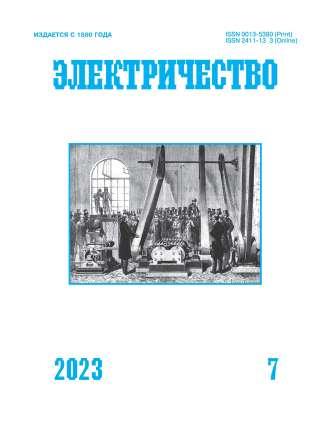Исследование частотных характеристик индуктивных датчиков в схемах измерения частичных разрядов
DOI:
https://doi.org/10.24160/0013-5380-2023-7-35-46Ключевые слова:
частичные разряды, индуктивные датчики, высоковольтные испытания, частотные характеристики, электрический метод измеренияАннотация
Анализ результатов измерений характеристик частичных разрядов в изоляции электрооборудования электрическим методом необходимо выполнять с учетом частотных характеристик как оборудования испытательной установки, так и элементов измерительной цепи, в особенности датчиков, в которых формируется отклик на сигналы частичных разрядов. В статье сформулированы методические основы подхода к определению этих частотных характеристик, минимизирующего погрешности измерения. Приведены и проанализированы частотные характеристики для индуктивных датчиков двух видов: на принципе трансформатора напряжения и трансформатора тока. Это позволяет проектировать датчики под решение конкретных задач измерения. Для датчиков на принципе трансформатора тока показано, что падающий характер фазочастотной характеристики ограничивает их рабочий частотный диапазон. Для датчиков на принципе трансформатора напряжения проанализировано влияние на частотные характеристики типа ферритового сердечника и входного сопротивления измерительного прибора. Показано, что путем выбора материала сердечника можно регулировать длительность отклика и обеспечить раздельную регистрацию часто повторяющихся разрядов. Определено условие обеспечения колебательного характера отклика от индуктивного датчика, подключенного к низкоомному входу измерительного прибора. Приведены рекомендации по конструктивному исполнению датчиков для снижения искажения и ослабления сигналов.
Библиографические ссылки
2. Вдовико В.П. Частичные разряды в диагностировании высоковольтного оборудования. Новосибирск: Наука, 2007, 155 с.
3. Русов В.А. Измерение частичных разрядов в изоляции высоковольтного оборудования. Екатеринбург: УрГУПС, 2011, 370 с.
4. CIGRE Technical Brochure No. 366. Guide for Partial Discharge Measurements in Compliance to IEC 60270, 2008, 56 p.
5. CIGRE Technical Brochure No. 662. Guidelines for Partial Discharge Detection Using Conventional (IEC 60270) and Unconventional Methods, 2016, 115 p.
6. CIGRE Technical Brochure No. 676. Partial Discharges in Transformers, 2017, 162 p.
7. IEC 60270:2000+AMD1:2015 CSV. High-Voltage Test Techniques – Partial Discharge Measurements, 2015, 226 p.
8. ГОСТ Р 55191-2012 (МЭК 60270:2000). Методы испытаний высоким напряжением. Измерения частичных разрядов. М.: Стандартинформ, 2014, 47 c.
9. Qiong F. et al. New Type of Pulse Current Sensors for on-Line Partial Discharge Monitoring. – 7th International Conference on Properties and Applications of Dielectric Materials, 2003, pp. 298–301, DOI: 10.1109/ICPADM.2003.1218411.
10. Siddiqui B.A., Pakonen P., Verho P. Novel Sensor Solutions for On-line PD Monitoring. – 23rd International Conference on Electricity Distribution, Lyon, France, 2015, p. 1200.
11. Siddiqui B.A., Pakonen P., Verho P. Novel Inductive Sensor Solutions for On-line Partial Discharge and Power Quality Monitoring. – IEEE Transactions on Instrumentation and Measurement, 2017, vol. 70, No. 1, pp. 209–216, DOI: 10.1109/TDEI.2016.005908.
12. Paophan B., Kunakorn A., Yutthagowith P. Partial Discharge Measurement Based on an Inductive Mode Air Core Sensor. – Journal of Electrical Engineering & Technology, 2020, vol. 15, pp. 773–785, DOI: 10.1007/s42835-020-00376-y.
13. Klüss J.V., Elg A.P., Wingqvist C. High-Frequency Current Transformer Design and Implementation Considerations for Wideband Partial Discharge Applications. – IEEE Transactions on Instrumentation and Measurement, 2021, vol. 70, DOI: 10.1109/TIM.2021.3052002.
14. Fritsch M., Wolter M. High-Frequency Current Transformer Design and Construction Guide. – IEEE Transactions on Instrumentation and Measurement, 2022, vol. 71, DOI: 10.1109/TIM.2022.3177189.
15. Qian S. et al. BaTiO3-Refined NiCuZn Ferrites Towards Enhanced Pulse Detection Sensitivity for a High-Frequency Current Transformer. – Journal of Electronic Materials, 2023, vol. 52, iss. 1, pp. 583–592, DOI: 10.1007/s11664-022-10029-7.
---
Исследование выполнено за счет гранта Российского научного фонда № 23-29-00934, https://rscf.ru/project/23-29-00934
#
1. Korobeynikov S.M., Ovsyannikov A.G. Fizicheskie mekhanizmy chastichnyh razryadov (Physical Mechanisms of Partial Discharges). Novosibirsk: NGTU, 2021, 266 p.
2. Vdoviko V.P. Chastichnye razryady v diagnostirovanii vysokovol'tnogo oborudovaniya (Partial Discharges in the Diagnosis of High-Voltage Equipment). Novosibirsk: Nauka, 2007, 155 p.
3. Rusov V.А. Izmerenie chastichnyh razryadov v izolyatsii vysokovol'tnogo oborudovaniya (Measurement of Partial Discharges in the Insulation of High-Voltage Equipment). Ekaterinburg: UrGUPS, 2011, 370 p.
4. CIGRE Technical Brochure No. 366. Guide for Partial Discharge Measurements in Compliance to IEC 60270, 2008, 56 p.
5. CIGRE Technical Brochure No. 662. Guidelines for Partial Dis-charge Detection Using Conventional (IEC 60270) and Unconventional Methods, 2016, 115 p.
6. CIGRE Technical Brochure No. 676. Partial Discharges in Transformers, 2017, 162 p.
7. IEC 60270:2000+AMD1:2015 CSV. High-Voltage Test Techniques – Partial Discharge Measurements, 2015, 226 p.
8. GОSТ R 55191-2012 (МEК 60270:2000). Metody ispytaniy vysokim napryazheniem. Izmereniya chastichnyh razryadov (High Voltage Test Techniques. Partial Discharge Measurements). М.: Standartinform, 2014, 47 p.
9. Qiong F. et al. New Type of Pulse Current Sensors for on-Line Partial Discharge Monitoring. – 7th International Conference on Properties and Applications of Dielectric Materials, 2003, pp. 298–301, DOI: 10.1109/ICPADM.2003.1218411.
10. Siddiqui B.A., Pakonen P., Verho P. Novel Sensor Solutions for On-line PD Monitoring. – 23rd International Conference on Electricity Distribution, Lyon, France, 2015, p. 1200.
11. Siddiqui B.A., Pakonen P., Verho P. Novel Inductive Sensor Solutions for On-line Partial Discharge and Power Quality Monito-ring. – IEEE Transactions on Instrumentation and Measurement, 2017, vol. 70, No. 1, pp. 209–216, DOI: 10.1109/TDEI.2016.005908.
12. Paophan B., Kunakorn A., Yutthagowith P. Partial Discharge Measurement Based on an Inductive Mode Air Core Sensor. – Journal of Electrical Engineering & Technology, 2020, vol. 15, pp. 773–785, DOI: 10.1007/s42835-020-00376-y.
13. Klüss J.V., Elg A.P., Wingqvist C. High-Frequency Current Transformer Design and Implementation Considerations for Wideband Partial Discharge Applications. – IEEE Transactions on Instrumentation and Measurement, 2021, vol. 70, DOI: 10.1109/TIM.2021.3052002.
14. Fritsch M., Wolter M. High-Frequency Current Transformer Design and Construction Guide. – IEEE Transactions on Instrumentation and Measurement, 2022, vol. 71, DOI: 10.1109/TIM.2022.3177189.
15. Qian S. et al. BaTiO3-Refined NiCuZn Ferrites Towards Enhanced Pulse Detection Sensitivity for a High-Frequency Current Transformer. – Journal of Electronic Materials, 2023, vol. 52, iss. 1, pp. 583–592, DOI: 10.1007/s11664-022-10029-7
---
The study was financially supported by the Russian Science Foundation, grant no. 23-29-00934, https://rscf.ru/project/23-29-00934




